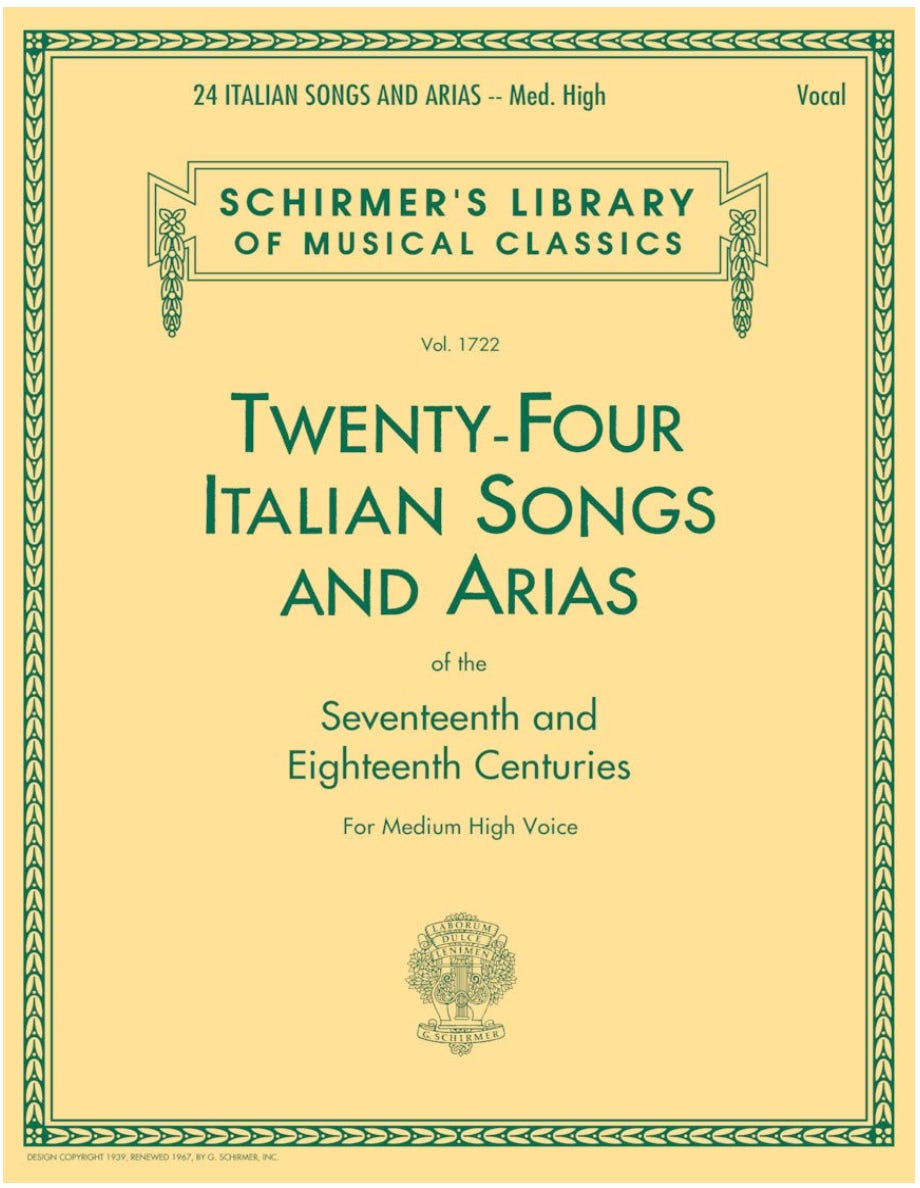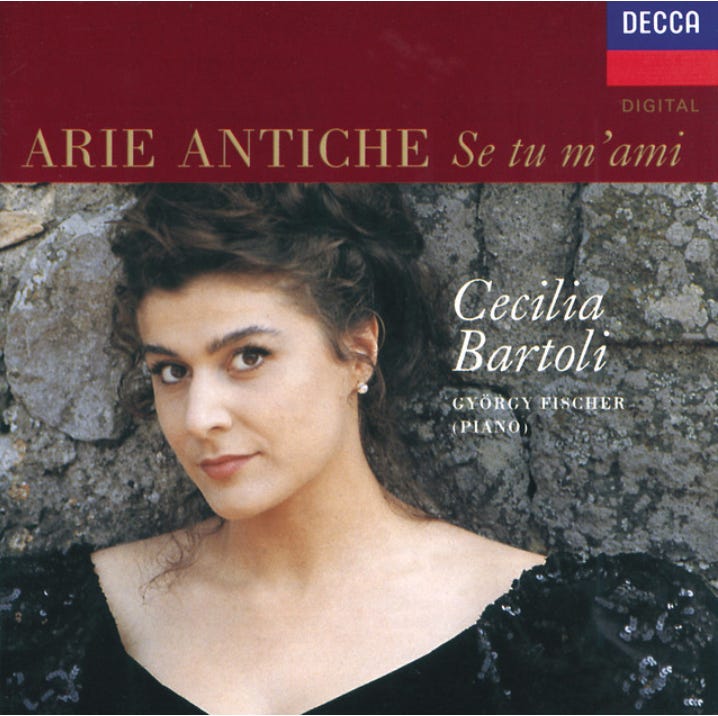Who's Afraid of Classical Singing?
Listening like a singer: a beginner’s guide to classical voices
Wimbledon just wrapped up, and over the past few weeks I’ve heard more about tennis than I thought possible. Everyone’s been talking about the “new era” of players, the rivalries, the drama. Honestly? I usually couldn’t care less.
But the other day at the gym, I was half-listening to my usual news podcast when they got to the tennis bit. I hovered over the skip button - then paused. Something about how they described it caught me. The scoring system designed to keep tension alive until the very last moment. The shifts in momentum. The mental game. Suddenly, I found myself thinking… maybe I should watch a match?
It reminded me of a conversation I had this week with a friend who told me she enjoys classical music, but finds classical singing hard to listen to. “It’s too much,” she said. “Too big.”
As a former opera singer, my first instinct was to prove her wrong. What’s the most stunning aria I can send? What’s the most beautiful example I know? But on the walk home, that tennis podcast came to mind.
Maybe it’s not that people dislike classical singing. Maybe it’s just never been explained in a way that makes it feel like something you’d want to root for.
So this week, I want to show you how singers themselves listen. What we look for. What we admire. What makes a voice impressive, or even beautiful.
Maybe it’ll convert you. Or maybe you’ll just walk away with a new way of hearing it.
One quick note before we dive in: I’ve included a playlist of most of the tracks below, but I think this one’s best experienced with the text. The clips and commentary go hand in hand, so feel free to read along as you listen. It’s also bit longer than usual - more of a guided tour than a snack-sized newsletter - so take it at your own pace. Dip in and out. Or skip to the high notes. I won't be offended.
1. The Breath – A Balancing Act
We’re starting at the beginning. Breathing. I mean, what is there to talk about? We all do it, right?
Yes. But how we do it is another story entirely.
This is where every singer begins, and honestly, it never stops being relevant. Breath is everything. It’s your fuel, your foundation, your emotional register. Think about it: when you panic or upset, your breath is shallow and fast. When you’re relaxed, it’s low and slow. Just imagine how your breathing changes in different situations - completely different patterns.
For singing, the aim is always a low, relaxed breath. Shoulders down. Stomach slightly out. It sounds simple, but it takes some training to get it right. And once you think you’ve nailed it? Your teacher will remind you to go back to it. Again and again.
Okay, so you’ve got the hang of breathing deeply. Now what? How much air do you actually use?
Too much - and your sound is weak and breathy. You’ll never make it through a long phrase, and your tone will fall apart.
Too little - and the sound gets stuck. You tense up, strain your throat (well, technically your larynx, but let’s keep it simple), and the result is… not pleasant.
So what you need is balance. Just enough air to let the vocal folds vibrate freely (this can actually be measured scientifically - what we perceive as a “healthy” movement), but not so much that you run out of steam halfway through a line. This is what singers call air management. And it’s everything.
There’s this iconic beginner’s book called 24 Italian Songs and Arias. If you’ve ever studied classical voice, you’ve probably sung from it. The songs are short, not too technically challenging, and they quietly sneak in all the essential techniques singers need to master.
So, let’s start with one of those classics: “Amarilli, mia bella.” It’s often one of the first “real” songs a singer learns. And I had to pick this version by Cecilia Bartoli - if you’ve been reading from the beginning, you’ll know she’s a favourite.
Bartoli is a master of air management. When you listen to her sing this, notice how easily she breathes. You can barely hear it. Then notice how long she goes without taking a breath. It’s almost ridiculous.
Now go one step further - listen to how the sound changes within each phrase. The swell and release of the line. That’s another tool breath gives you: control over the shape and emotion of each note. You can move the air faster or slower to create more intensity or softness. Think of it like painting with air.
Bartoli makes it sound easy - and that’s the point. That ease is what people mean when they say someone has “great technique.” It’s that smooth, unlaboured, almost invisible control. That’s classy singing.
Side note: One of Bartoli’s early albums (sadly no longer on Spotify *shakes fist*) was a collection of songs from the 24 Italian Songs and Arias book. A strange choice, maybe - beginner songs when you’re still trying to make a name for yourself? But when you hear it, it makes perfect sense.
First, you rarely hear these songs sung by a professional. Second, Bartoli transforms each one. She’s not just singing scales- she’s telling stories.
It always felt to me like she was saying: “You think this stuff is simple? Watch what I can do with it.” That album completely changed how I thought about singing.
And since we’re talking about breath, here’s an absolute flex from Bartoli:
A live recording that made my jaw drop the first time I heard it. She’s doing something here that most singers wouldn't even try. Listen and see what you think.
One more breath master for good measure: the late Russian baritone Dmitri Hvorostovsky. This clip is from the Cardiff Singer of the World competition in 1989 - a grand title, but it’s genuinely one of the biggest international platforms for young singers.
Hvorostovsky was the winner that year. (Fun fact: Welsh hometown favourite Bryn Terfel also competed, but didn’t win the top prize - partly because of this performance and that year went down in opera lore as “The Battle of the Baritones,” which sounds like a Star Wars sequel but was, in fact, a real thing.)
Now, here’s what I want you to notice:
Don’t worry too much about the aria itself - just focus on his breathing. Or lack of it.
From about 1:09, he starts singing this impossibly long line. You expect him to take a breath around 1:23. But… he doesn’t. He just keeps going.
And he does it again on the repeat. In a competition. Live. On camera. While keeping his cool like it’s nothing.
Here’s the clip:
Knowing how emotional and high-stakes that moment was, and how breath is tied so closely to emotion, this is just... mind-blowing.
2. Tone: More Than Just a Pretty Sound
Okay, now we’re getting a little more technical - but stick with me.
What makes a beautiful tone? It sounds subjective, right? One person’s goosebumps is another person’s “meh.” And sure, we all have different tastes. But there are some shared ideas about what makes a voice beautiful, especially in classical singing.
A teacher once said to me, “There’s nothing natural about singing opera. No one is born able to sing over an orchestra without a microphone to 5,000 people.” And she was absolutely right. So a lot of what makes a tone “beautiful” is, in part, shaped by necessity - by the need to be heard.
You can’t shout. You’d lose your voice after ten minutes. So classical singers are trained to create a sound that’s both powerful and sustainable. The result? A tone that carries, resonates, and (hopefully) still sounds pleasing after two hours on stage.
Wait… Why Can’t I Understand What They’re Singing?
Great question.
There are five “pure” vowels:: A, E, I, O, U. Every word has at least one of them, or a variation - think about the difference between feel and fill.
But here’s the problem: to be heard over an orchestra and keep your voice healthy, you often have to adjust those vowels. It’s called vowel modification.
So “A” might morph into more of an “O,” and “I” might shift toward an “E” or even “A.” These are very broad strokes - singers make subtle shifts depending on pitch, voice type, and language.
Add to that the fact that consonants - t, p, b, l, k, etc. - interrupt airflow. If you overdo them, they break the line. So some singers soften them. Some lean into them for drama. And that’s why sometimes the words get a little… fuzzy.
Here’s a nerdy example that still makes me laugh.
In Massenet’s Manon, there’s an aria that starts with the line “Suis-je gentille ainsi?” (“Am I nice like that?”). Manon’s just come into money and is feeling herself.
If you’re not a French speaker, the last word - ainsi - is pronounced something like uh-see. But when you listen to Renée Fleming sing it:
…it’s uh-suh. For years, I thought that was the actual word. But no - she’s just modifying the vowel to make the line ring. And honestly, I haven’t heard a version where the singer doesn’t do this. It’s just what works vocally and acoustically.
To show you the difference in tone focus, let’s look at two very different versions of the same song.
First, Joan Sutherland - an absolute legend, with a lush, flowing voice and an incredible vocal range. But she often got flak for how indistinct her diction was. Words came second; vowels came first.
Now compare that to Cecilia Bartoli - yes, her again. She loves consonants. She rolls her R’s, pounces on hard sounds, and uses every tool to tell the story.
Same song. Completely different tone approach.
Neither is right or wrong - it’s just a different lens on what makes tone beautiful.
Even = Beautiful
The second big thing singers aim for is evenness. The voice should feel smooth from bottom to top - no gear changes, no bumps, no cracks. Just one long ribbon of sound.
In reality? No voice is perfectly even. Different parts of your vocal range naturally sound different, and should, because the acoustics shift. But the trick is to manage the transitions so you don’t hear the join.
This is where the infamous passaggio comes in—Italian for “passage.” It’s the awkward middle bit of your range where things can go very wrong if you're not careful. Singing teachers talk about it a lot. It's like the vocal version of a pothole on an otherwise smooth road.
You’ll also hear terms like chest voice and head voice - and we could go deep into overtones and formants here (but we won’t). What matters is: the illusion of evenness is part of what makes a voice sound great.
Then there’s vibrato - the natural, gentle wobble in pitch that happens when your voice is relaxed and well-coordinated. Think of it as a little shimmer or pulse that gives the sound warmth and life. Believe it or not, there’s a sweet spot:
5–7 oscillations per second is ideal.
Slower than that? It’s a wobble (yes, that’s the actual term).
Faster? It’s a bleat—and yes, we mean like a sheep.
Brutal, I know.
3. It’s Show Biz
At the end of the day, people come to hear singing to be moved, thrilled, or just flat-out entertained.
Singing is an emotional experience. But let’s be honest: singers, more than anyone I know, love to show off. And really, who can blame them? Once you’ve trained for years to master your instrument (your literal body), why wouldn’t you use it to dazzle a crowd?
There are a few reliable ways to make an audience lose their mind:
High notes = High drama
High notes are a guaranteed crowd-pleaser. For sopranos (the high female voice type), it can feel like an Olympic sport. Who can go higher? Who can hold it longer? And yes, the competition is real - on and off stage.
One of my favourite tongue-in-cheek examples is this hilarious little trio from Mozart’s musical comedy Der Schauspieldirektor (The Impresario), where two sopranos are fighting (musically, of course) for the title of prima donna. (Video quality: questionable, quality singing: outstanding)
Yvonne Kenny and Judith Howarth go toe-to-toe and top-to-top—so good.
The Lower You Go, The More They Pay
Low notes don’t get the same spotlight, but they should. Singing deep, rich bass lines isn’t easy, and true basses, especially the elusive basso profundo (that’s “profound bass” in Italian), are rare and highly sought-after.
In fact, they can command some of the highest fees in the business, simply because that voice type is so uncommon.
Here’s Finnish bass Matti Salminen singing one of the most iconic low-voice arias, “O Isis und Osiris” from Mozart’s The Magic Flute.
Fast & Furious
Now we’re talking technique. Singing fast, and cleanly, is hard. Some singers can do it naturally, others have to work at it for years. And ironically, learning to sing fast starts by doing everything… slowly.
Rush it, and it falls apart: you slide over notes, trip over consonants, and the whole thing turns into a mushy mess.
The term for this kind of fast, agile singing is coloratura, and few have built a career on it quite like Joyce DiDonato. Early on, she was the mezzo soprano for roles that needed vocal fireworks. Check her out here:
Fun insider detail: that high note at 4:56, It’s not written in the score. And Joyce isn’t even a soprano - she’s a mezzo (a lower female voice type). The audience knows this aria inside out, so when she throws that note in, you can hear the gasp. A moment of pure show biz perfection.
But don’t worry, the men can do it too.
Check out Peruvian tenor Juan Diego Flórez flying through vocal acrobatics like it’s nothing:
The Big Guns
And finally, volume.
Singing loud is its own kind of flex. And in a big hall, when someone really opens up and unleashes a massive, ringing note? You feel it. It’s like the sound wraps around you, or pins you to your seat.
There’s definitely some friendly (and less friendly) rivalry between singers over who can sing the loudest. It’s a bit of a badge of honour. Certain roles require that kind of power, and if you’ve got it, you’ll be in demand. That said, singing loud doesn’t always equal singing well.
I’ve been in huge theatres—3,000 seats—and still felt like a singer was right in my ear.
No one understands vocal size quite like Wagner singers. Wagnerian roles are famously demanding, and singing them is almost its own category of performance. The stamina, the volume, the emotional weight - it’s no joke.
One of the biggest voices I’ve ever heard live belongs to American soprano Christine Goerke. It’s hard to describe: when she sings full out, it’s like a wall of sound coming at you. You can’t dodge it.
Here she is in a famous battle cry from Wagner’s Die Walküre. If you’ve ever seen Apocalypse Now, you’ve probably heard this music. Brünnhilde’s "Hojotoho!" – Ride of the Valkyries
Honestly, just hearing this snippet through your headphones might not prepare you for what it’s like live. But it gives you a taste of what a “big voice” really means.
Okay, I’m going to stop here because honestly, this is just the beginning. I haven’t even touched on musicality, phrasing, languages — or all the singers who mastered the rules just to break them in the most thrilling ways.
But I can’t finish a newsletter about classical singing without mentioning Luciano Pavarotti. The Italian tenor who’s still a household name - and for good reason.
I sometimes ask friends who play other instruments whether a certain player is actually the real deal, or just a PR job. So let me be unequivocal: Pavarotti had one of the most extraordinary voices ever recorded. He nailed all of the above — breath, tone, vowel modifications, and the kind of effortless showmanship singers dream about.
But beyond all that, there’s something else. A spark. A particular kind of resonance that hits you in the chest and feels completely unteachable.
Here he is in his full glory. What. A. Voice.
Thanks for sticking with me - I hope this sneak peek into classical singing piqued your interest, or at least gave you a few tools for how to listen when a classical singer starts doing their thing.
There’s a lot to know, sure, but opera and classical singing aren’t just for the experts. I hope you found something here that surprised or you enjoyed.
I’d love to hear what you thought of this slightly longer guide , and if you’re still curious or have questions, drop a comment below or feel free to send me a message. Always happy to chat vowels, volume, and Verdi.
Happy weekend!







